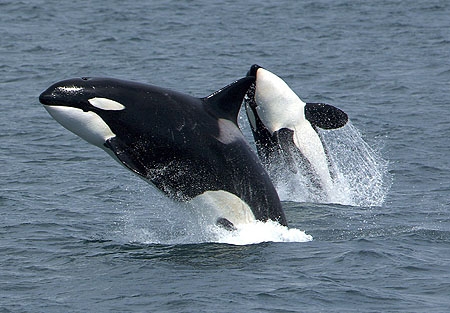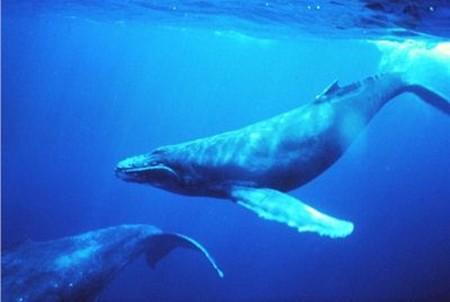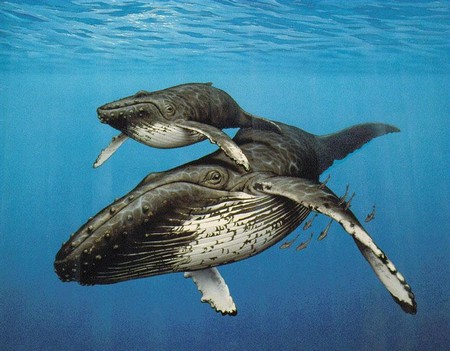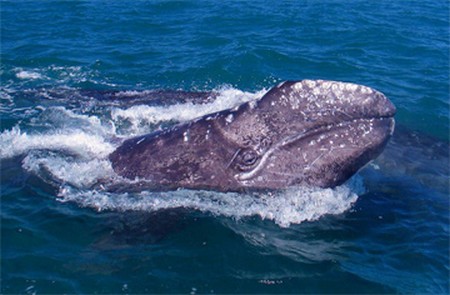Whenever you hear the term whale, you may have thought about the large white gargantuan, killer whale called ‘Moby Dick’ looking for prey in the southern seawaters, or you may have thought about an enormous, nice and endearing Orca Whale called ‘Willy’.
For most of the people whale is a fish, but it isn’t true because whale is basically a mammal belongs to the order Cetaceans, i.e. a highly specialized order of mammals. Whales are broadly categorized into two groups characterized by the presence or absence of teeth, i.e. Odontoceti and Mysticeti. Being mammal in nature, whales do breathe air. Whales normally feed their young ones on their milk for almost a year. During this time, the young ones stay with the mother. Whales are also warm blooded creature with a proper skeleton structure.
Although, whales can be seen commonly in the oceans all across the world, these are more common in the Arctic and the Antarctica. This is so because whales enjoy living in cold, deep waters. Whales have also been seen in the warm waters of Hawaii, Bahamas and The Gulf of Mexico along with the eastern coast of America. Some rare sightings have also been seen in the Columbia River where they travelled about 110 mi in search of food. The seasonal movements of the whales are subject to the migration of fish, aquatic creatures and pack ice.
Whales are known to be the largest aquatic predator that feed on about 3-4 percent of food of their body weight. They don’t spare any aquatic creature and prey any available aquatic creature. They also eat polar bears, reptiles, and moose. They prey in pods. It is important to make distinction here between the resident pods and transient pods. The former largely feed on fish and hardly go for aquatic mammals, while the latter follow the exact opposite.
Blue Whale
Blue whale is considered as the largest mammal found on the planet Earth. The mature female blue whales are usually larger than the mature adult males. On average, a normal blue whale can grow up to the size of 105 feet with weight around 200 tons. Blue whales are normally shy and docile irrespective of their size. Blue whales normally found exploring the waters in small groups or pairs. Most of the blue whales spend their summer season in the polar waters, while they move along the equator in winter season. A daily diet of blue whales composed of 4 tons of krill and other aquatic creatures such as shrimps. Blue whales are known to produce succession of sounds for the purpose of communicating to other whales even up to the distance of 1,000 miles. Another aspect of this sound system is brought to us by scientists according to which they used their vocal system to sonar (calculate ocean’s depth) as well.
Orca Whales
Orca whales are widely known as ‘killer whales’ as they are strong, vigorous predators. An orca whale can grow up to the size of 82-105 feet with a weight of about 200 tons. An orca whale can live up to 80-90years in the wild. Most of the orca whales can be seen along the coastal waters; however, these are also frequent in the areas closer to the equator. Orca whales feed on fish and other aquatic mammals. An interesting fact about them is that these whales can even snatch the polar bears and seals right from the ice with the help of four inch long teeth. They also have a distinct vocal system to communicate with each other. Each pod of orca whales has its own particular communicating sounds. These are found in black and white color.
Humpback Whales
Humpback whales are popular because of their magical songs used to communicate with other whales or even to draw the potential mates towards them. The duration of these songs can range from few minutes to several hours. An average size of the humpback whale is 48-62 feet with a weight of about 40 tons. Humpback whales are omnivores and can feed on fish, tiny shrimp-like krill and planktons. They are strong swimmers and use there tail fin known as fluke to thrust and jump out of the water. These whales migrate seasonally for the sake of breeding and feeding.
Beluga Whales
Beluga whales are commonly known as white whales. It is interesting to note that these whales when born are brown or gray in color and turn white when they became sexually mature. Their color makes them distinguish from other species of whales. Beluga whales are found in the waters of Arctic Ocean coast and in subarctic waters. Beluga whales are 13-20 feet in size with a weight of about 2200 pounds. These are found in small pods and normally hunt together. Beluga whales usually feed on schooling fish which are abundant at coastal waters. The two most distinguished features of these whales are: first, they swallow their prey without chewing them; second, they have the ability to turn their necks in different directions because of having flexible necks.
Fin Whales
Fin whales are commonly referred to as ‘greyhound of the sea’ for their extremely fast speed. Fin whales are found in the oceans all across the world. These whales live in a group of small pods or even alone in some cases. These whales migrate seasonally with a view to breed. The most distinguished feature of these whales is their ability to dive deep into the water, to say as deep as 800 feet. These whales feed on squids and fish. An average fin whale normally weighs about 70 tons and can grow up to the length of 90 feet. In winters, these whales usually depend on blubber for energy rather than hunting.
Gray Whales
Gray whales are known for their migrating instinct. It is said that these whales travel about 12,430 miles from Alaskan waters to the Mexican coast. Gray whales are one of the oldest species of whales which is found in mottled grey color with coverings of abrasions, scars and clusters of parasitic barnacles on heads and backs. These whales can grow to the length of 40-50 feet with a weight of about 40 tons. Gray whales are omnivores and enjoy feeding on amphipod crustaceans. Scammon’s Lagoon, of Baja California is an example of gray whales.
Sperm Whales
Sperm whales get their name from the milky white waxy substance spotted on its head. This substance is assumed to be sperm. Sperm whales are known to have the largest brain of all the other animals found on this earth. These whales are usually 59 feet in length with a weight of about 35 to 45 tons. These whales enjoy feeding on giant squid, but it also hunts other aquatic species.
These are some of the common types of whales. The human cruelty has endangered the existence of this mighty creature. These are hunted by humans on a large scale. Several organizations are working in a view to save this creature before it becomes extinct. The WWF Cetaceans Action Plan is hoping to reduce the numbers of hunting cases significantly by the end of 2012. Certainly, these aquatic mammals have something in them to keep the interest alive in them no matter how dreadful they can be.







